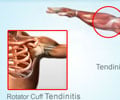Scientists have identified a key component of tendons which could help treat tendon disorders.

"Tendon disorders are highly debilitating and painful, and may herald the end of an Olympic athlete's career," said co-author Dr Hazel Screen, a senior lecturer in medical engineering at Queen Mary, University of London.
"Even today, with advancements in sports science, little is known about tendon health management, and we still do not understand why some people are more prone to tendon injury than others.
However, we have now found that the matrix which binds the fascicles together in the tendon, the IFM, is essential for tendon function and that changes to this structure may be responsible for tendon injury."
Scientists at Queen Mary, along with colleagues from University of Liverpool and University College London, are working on a project funded by the Horserace Betting Levy Board, in which they have been dissecting tendons from horses in order to better understand the role of the IFM.
Tendon injury is common in horses as well as humans, with an economic impact of more than £3bn a year in horse racing. Around 16,000 horses are in training each year and the tendon injury rate is as high as 43% with few horses returning to racing after injury.
Advertisement
"We tested how the components within the SDFT worked to enable the tendon to stretch and function effectively.
Advertisement
The finding suggests that the IFM may be critical in preventing tendon overuse injury, and the authors are now trying to find out exactly how this is achieved.
Dr Screen added: "If we are able to manipulate the IFM, we could potentially design a diagnostic test to see whether someone is more susceptible to tendon injury than others, and also pave the way for prospective treatments."
Source-Eurekalert














